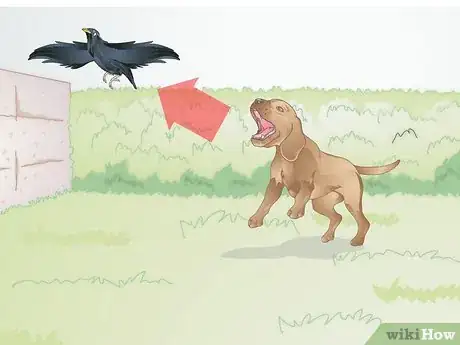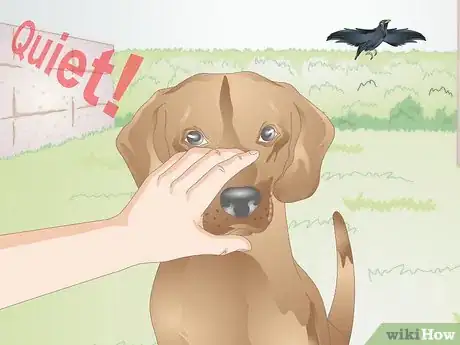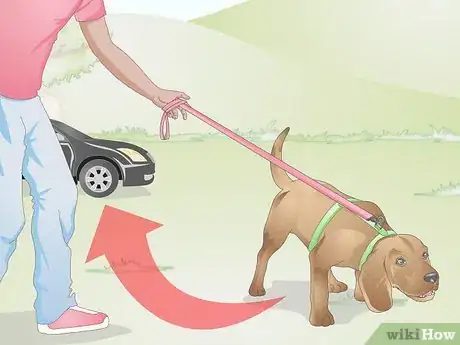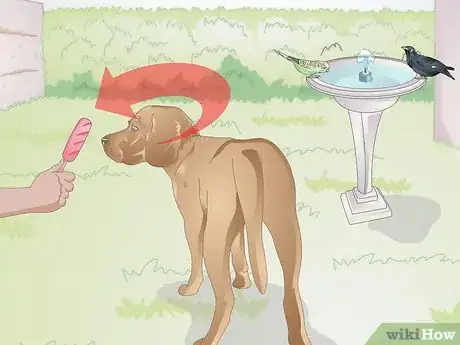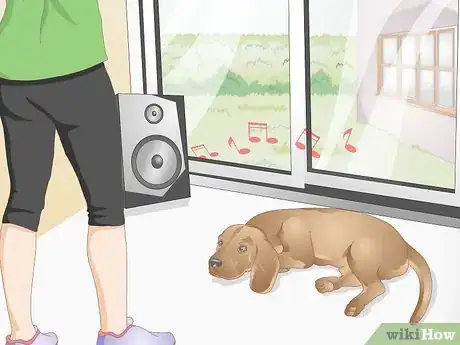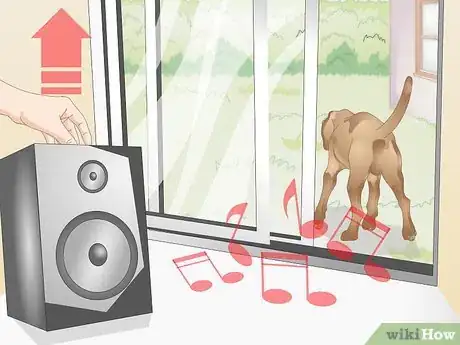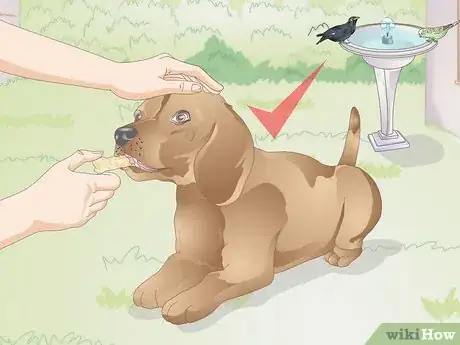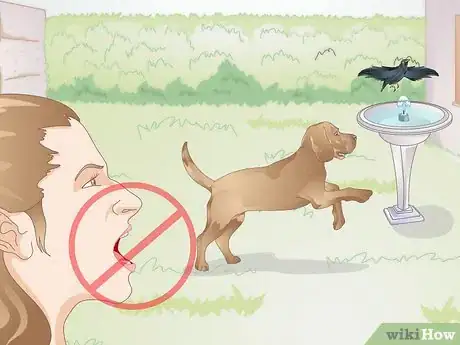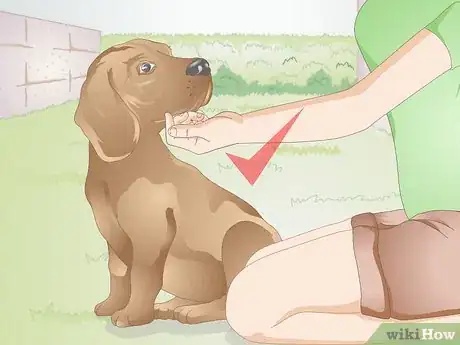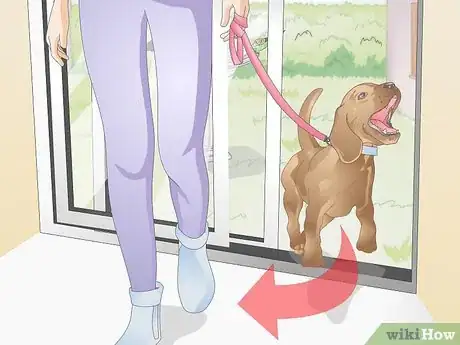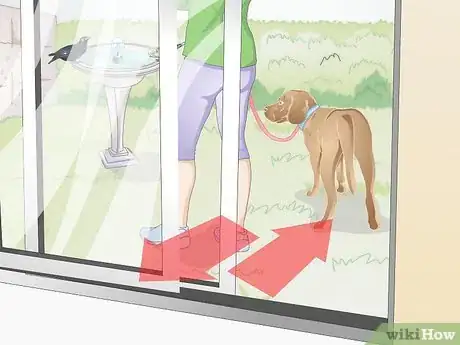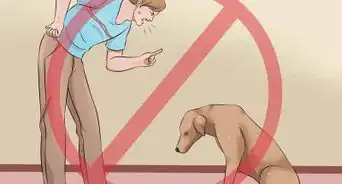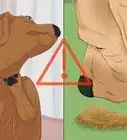This article was co-authored by Indigo Will. Indigo Will is a Canine Expert, Trainer, and Founder and Owner of K9-INDIGO® Holistic Dog Training LLC™, a dog training service in Los Angeles, California. Indigo specializes in understanding canine temperament and dispositions to allow canines to reach their full potential. He has studied various methods of training and philosophies to develop a unique, innovative, and result-driven method for canine behavior training.
There are 7 references cited in this article, which can be found at the bottom of the page.
This article has been viewed 49,476 times.
Although dogs make great pets, they can be very excitable and can act erratically when near birds. When startled by birds, dogs can bark incessantly and often want to chase the birds. In this scenario, dogs will also often run away from their owners or completely ignore any commands directed towards them. This can be a frustrating experience for dog owners. To calm your dog when it sees birds, you’ll need to reinforce quiet, calm behavior, punish negative behaviors, and not yell at your dog to quiet its barking or prevent it from running.
Steps
Teaching your Dog to Ignore Birds
-
1Recognize that chasing birds is normal behavior. Like all predatory animals, dogs are stimulated by seeing bursts of motion and creatures—especially prey-sized creatures—running or flying away from them.[1] Your dog may instinctively see the birds as prey, and will consequently bark and chase the birds.[2]
- You’ll notice that the same instinct kicks into effect when your dog sees other fast-moving or loud animals, including squirrels, rabbits, snakes, and chipmunks.
-
2Make sure your dog gets plenty of exercise. Dogs who display excessive barking or hyperactivity—including when they see birds—may simply need more exercise. A lack of exercise often leads to loud, poorly behaved, and easily distracted dogs.[3] Make sure your dog is getting plenty of exercise each day; this may diminish their excitement when seeing birds.[4]
- Although the amount of exercise your dog needs will vary by breed, puppies should be given multiple, short walks or play-sessions throughout a day, while adult dogs may benefit more from a single, longer and more rigorous walk.
- Take time to walk your dog daily (unless you live in an area where your dog can run on its own), and be sure to play with your dog—whether indoors or outdoors—daily also. If your dog is of an especially active breed, consider training your dog to compete in agility, rally, or dog shows.[5]
Advertisement -
3Decrease your dog’s territorial behavior. Dogs are naturally territorial creatures, so your dog may bark or act aggressively because it’s afraid that the birds threaten its territory. If your dog is barking to defend its territory, teach it to stop barking after 3 or 4 barks by giving the command “quiet” and then gently holding the dog’s muzzle shut.[6] Once your dog remains quiet, give it a treat, and praise and pet the dog.
- Continue this behavioral training until the dog remains calm once you have given the “quiet” command, or until the birds have left the vicinity.
- You may also need to restrict your dog’s field of vision when it’s indoors, so that it can’t see out of the windows and feel obliged to protect its “territory.”[7]
-
4Discourage your dog from chasing or barking at birds. You can do this by walking your dog around your backyard, or a nearby park, with a leash on. If there are birds in the area and your dog starts to bark or run after them, simply bring the dog back inside (or back to your car).[8]
- On the other hand, when your dog is quiet or well behaved around birds, praise the dog and give it a treat or a piece of food to encourage its good behavior.
- Eventually, your dog will learn that it receives a reward when it is calm and well behaved around birds, and should change its behavior accordingly.
-
5Distract your dog from the birds. If you can capture your dog’s attention and direct it away from the birds, you can help your dog to behave calmly when it is tempted to run or bark. If your dog is barking at nearby birds, instead of dragging it away, simply walk over holding a dog treat—or a piece of meat or hot dog—in your hand. Then, lead your dog away from the birds—this will distract your dog, and it should quiet down.[9] Teach your dog a "Look" or "Watch me" command to make this easier.
- Give the dog the meat once it has quieted down, and praise its good behavior.
- If you want to bring your dog indoors (or back to the vehicle if you’re on a walk), you can lead it inside once it’s quieted down. Over time, the dog will learn that its calm behavior is rewarded, and will be less inclined to bark at or chase after birds.[10]
Desensitizing Your Dog to Birds
-
1Play a quiet recording of bird sounds for your dog. The idea behind this method is that, if your dog hears birdsongs frequently—especially in locations where the dog is otherwise calm—it will be desensitized to the sound of birds and no longer chase or bark at birds outdoors.[11] Find a bird recording online on a site such as YouTube, and play it around the house at a low volume.
- If your dog is initially excited and tries to “find” or “chase” the bird, play the recording at a lower level.
- At this point, your dog will start to acclimate to the soft birdsong and will stay calm while the sound plays.
-
2Increase the volume, and eventually take your dog outside. As you increase the volume of the birdsong, your dog should become desensitized to louder levels of birdsong.[12] Once you can play the sounds at a “normal” level—approximately the volume of birds outdoors—try bringing your dog outside. The outdoor sounds of birds should stimulate your dog no more than the indoor bird recordings.
- Your dog should be desensitized to the birdsong, since it has heard it so frequently indoors.
-
3Reward your dog’s calm behavior. Once your dog is outdoors and is well behaved, calm, and is less inclined to bark at or chase birds, you should reward the dog. Praise your dog for its good behavior, pet it, and give it treats to reinforce its calm behavior.[13]
- If your dog continues to act out by barking at or chasing birds, bring it back inside. Vary the types of birdsongs that you play. This will desensitize the dog to a variety of types of birds. The next time that you bring the dog outdoors, it is more likely to disregard the sound and presence of chirping birds.
Rewarding Your Dog’s Calm Behavior
-
1Do not yell at your dog to quiet it. Dogs are naturally vocal animals and, if they hear you loudly vocalizing back at them, they’ll feel stimulated and continue barking and running at the birds. Even if you take an angry tone with your dog, or yell “No!” or other loud commands, your dog will interpret your shouting as a reward.[14]
- Dogs feed off of your own excitement, and appreciate the attention you’re giving them (even if it’s negative attention).
-
2Give your dog attention when it has quieted down. Wait until your dog’s excitement over the birds has passed (the birds have flown away or your dog has lost interest). Then, wait about five minutes, and pet and praise your dog. Over time, your dog will come to understand that you praise them for their silence and good behavior.[15]
- The same principle applies when you’re out on a walk with your dog, although it can be harder to implement. If your dog barks at or chases birds while you’re walking, do not yell at or discipline your dog, but keep it close to your side (don’t let the dog run). Then, once the dog has quieted down, praise the dog and give it a treat. This will positively reinforce its quiet behavior.[16]
-
3Bring your dog indoors if it does not calm down. Rather than shouting at a dog that is barking at or running after birds, simply bring it indoors. Wait until the dog has calmed down sufficiently (try waiting 10 minutes), and let the dog out again only once it is quiet.[17]
- Even if there are still birds outside, your dog will eventually that learn that, in order to be left outside, it needs to remain well behaved.
-
4Repeat the procedure as many times as needed. Dogs can be slow to learn and may have a strong drive to chase and bark at birds, especially if the dog is of a hunting breed. Whether you’re at your home or out on a walk, continue to reinforce quiet, calm behavior. Bring your dog back inside (or back from the walk) as often as needed for it to change its behavior and remain calm around birds.[18]
- Although at first it may be inconvenient to bring your dog inside the house every time it barks at or chases birds, it will reinforce the behavior and help your dog to remain quiet around birds.
References
- ↑ Indigo Will. Professional Canine Expert. Expert Interview. 8 September 2020.
- ↑ https://www.cesarsway.com/dog-behavior/obsessive-behavior/prey-drive
- ↑ Indigo Will. Professional Canine Expert. Expert Interview. 8 September 2020.
- ↑ http://www.akc.org/content/dog-care/articles/how-much-exercise-does-dog-need/
- ↑ http://www.akc.org/content/dog-care/articles/how-exercise-their-dogs/
- ↑ http://www.aspca.org/pet-care/dog-care/common-dog-behavior-issues/barking
- ↑ http://www.aspca.org/pet-care/dog-care/common-dog-behavior-issues/barking
- ↑ https://www.cesarsway.com/dog-behavior/obsessive-behavior/prey-drive
- ↑ https://www.cesarsway.com/dog-behavior/obsessive-behavior/prey-drive
- ↑ https://www.cesarsway.com/dog-behavior/obsessive-behavior/prey-drive
- ↑ http://shibashake.com/dog/how-to-calm-a-fearful-reactive-dog
- ↑ http://shibashake.com/dog/how-to-calm-a-fearful-reactive-dog
- ↑ http://shibashake.com/dog/how-to-calm-a-fearful-reactive-dog
- ↑ http://thebark.com/content/victoria-stilwell-how-deal-out-control-barking
- ↑ http://thebark.com/content/victoria-stilwell-how-deal-out-control-barking
- ↑ http://thebark.com/content/victoria-stilwell-how-deal-out-control-barking
- ↑ http://thebark.com/content/victoria-stilwell-how-deal-out-control-barking
- ↑ http://thebark.com/content/victoria-stilwell-how-deal-out-control-barking
- ↑ http://www.aspca.org/pet-care/dog-care/common-dog-behavior-issues/barking
About This Article
To calm a dog when it sees birds, try distracting your dog by offering it a treat or a piece of meat. You can also teach it the command “Quiet” by holding its muzzle shut after 3 or 4 barks and repeating the command. When it quiets down, praise it and give it a treat to reinforce the good behavior. If you can’t make it stop barking, take the dog inside or back to your car, and only let it out once it has calmed down. Additionally, avoid yelling at your dog when it's excited, since that will only reinforce the negative behavior. For tips from our Veterinary co-author on how to train your dog to ignore birds, read on!
